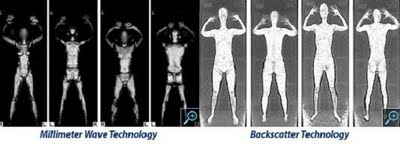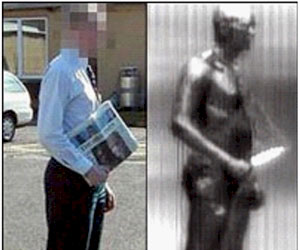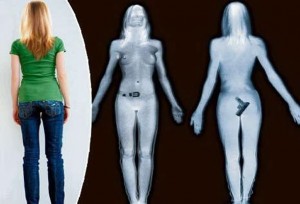Can you tell which is which at a glance? Even otherwise tech-savvy folks like those at Ars Technica sometimes get it wrong. Once you understand the physics, you can tell which kind of scanner produced which image, at a glance.


Millimeter wave scans bounce very short wavelength radar signals off your body to create an image. These scanners (at least the L-3 SafeView scanners) operate under an FCC waiver in the 24.25GHz-30GHz frequency range (wavelength 10-12mm). Millimeter wave signals reflect well from the body and particularly strongly from metal objects. A metal knife or gun shows up as a bright splotch in a millimeter wave scan. Millimeter waves should also reflect strongly from high dielectric constant materials like glycerin or titanium dioxide.
The reflectivity of backscatter x-rays depends upon atomic number (or “Z”). The lower the atomic number the stronger the reflection and the brighter the image. Organic matter, like your body, is made of relatively low Z matter like carbon, oxygen, hydrogen, and nitrogen. This strongly reflects the X-rays yielding a brighter image. Lithium would also be a strong reflector. High Z materials, like most metals, will reflect poorly, showing up as dark splotches. Certain skin creams, like zinc oxide (used in sunscreen or baby diaper rash treatment), or titanium dioxide (also used in sunscreen) should reflect poorly. Iodine would also tend to be fairly absorptive. Lead should be particularly dark in an image. Here’s a really good technical discussion from one of the manufacturers’ web sites.
Here are a couple of images with which to test your new skill. Highlight the white font caption below each image to check your answer.
 Dark metal objects against a ghostly white body? X-Ray scan. Source: NIST
Dark metal objects against a ghostly white body? X-Ray scan. Source: NIST
Incidentally, somehow the NIST image above made it into a “T-wave” graphic which was picked up by Reason Magazine, The Daily Mail, and elsewhere. T-waves or “terrawaves”are even shorter wavelength signals that should behave like millimeter wave images but potentially with higher resolution.
 The brightest return comes from a metal knife hidden in the newspaper. Millimeter wave. Source: NIST
The brightest return comes from a metal knife hidden in the newspaper. Millimeter wave. Source: NIST
Here’s a really tricky one:
Looks like an x-ray scan with a ghostly white body and dark metal (gun and belt), right? Wrong. It’s a fake. Hair isn’t substantial enough to reflect X-Rays. Someone took a standard photo, inverted it, and modified it with the gun and belt. Also in “real”images, faces are automatically blurred. See here for details.
Previously on ÆtherCzar:
How Full-Body Scanners Work – and Fail provided an overview of the technology. How X-Ray Backscatter Full-Body Scanners Work examined the relevant patents to see how X-ray scanners function. ÆtherCzar looked at the safety of X-ray scanners in Are Backscatter X-Ray Scanners Harmful? and Latest on X-Ray Backscatter Safety. ÆtherCzar also provided three collections of updates and links. Finally, ÆtherCzar passed on A Comprehensive Update on Body Scanners from Bruce Schneier and Bruce Schneier Interview – Security Theater and the TSA – Popular Mechanics.

